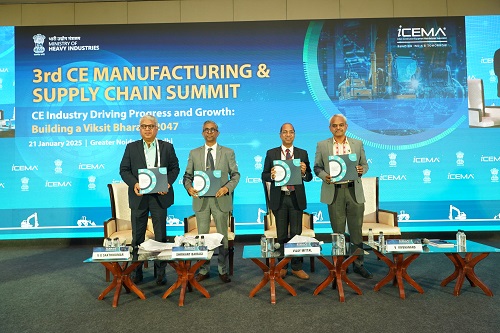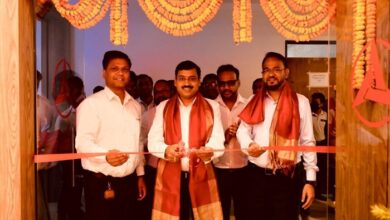Construction Equipment Manufacturing aligning with the targets of Viksit Bharat@2047

Resilience of local manufacturing supply chains is extremely relevant today as we aim to curb imports and achieve more than 50% indigenisation of components across the board, in the true spirit of Make in India,” said Mr. Vijay Mittal, Joint Secretary, Ministry of Heavy Industries, Government of India, addressing the 3rd Construction Equipment Manufacturing and Supply Chain Summit as the Chief Guest. The Summit was organized by the Indian Construction Equipment Manufacturers Association (ICEMA) – an affiliated body of CII in partnership with the Ministry of Heavy Industries (MHI), under the umbrella of the 1st edition of Bharat Construction Equipment Expo (BCEE) in Greater Noida on 21st January 2025. Emphasising the importance of R&D and its follow through on the ground in the context of reducing import dependence of heavy industries, he said, “It is very promising to see India’s growing contribution to academic output and the increasing numbers of patents being filed. However, the challenge lies in the commercialisation of this knowledge to make it market-ready. Mr. Mittal further added, “The share of capital goods in GDP needs to grow from its current level of 2 to 3 percent. For this the capital goods sector needs to grow at a higher rate than the GDP. The CE industry has a significant role to play in this, as one of the most proactive and responsive of the ten sectors under MHI. He also elaborated upon the role of the CE industry in enabling the nation’s economic development and the commitment of MHI in supporting the industry with a facilitative policy environment.“
As the Indian CE industry, which has been growing at a rapid pace over the past couple of years, stands poised to emerge as a global manufacturing hub, the 3rd CE Manufacturing and Supply Chain Summit, with the theme ‘CE Industry Driving Progress and Growth: Towards a Viksit Bharat@2047’, brought together industry stakeholders, policymakers and other thought leaders to deliberate upon the topics relevant to creating a thriving CE manufacturing sector in the country, underpinned by a robust supply chain. The Summit, which was well-attended by representatives of stakeholders including government body representatives, OEMs, component manufacturers, suppliers, research institutions, and end-users of Construction Equipment, hosted discussions on critical topics, namely, ‘Driving Innovation & Indigenisation: Making Indian CE Industry Atmanirbhar & a Global Manufacturing Powerhouse’, and ‘Building Resilience & Competitiveness with the support of a Robust Supply Chain’; with an aim to enhance the CE industry’s manufacturing prowess and enable the transformation of the industry into a powerhouse of global manufacturing of construction equipment.
Construction Equipment (CE), accounting for 20-30% of infrastructure investment, is pivotal to infrastructure development, connecting remote areas and driving economic growth. As the industry approaches the targets of CE Vision Plan 2030, to improve its global ranking from third to second by the end of the decade, the recently prepared CE Vision Plan 2035 defines future targets in preparation of the CE Industry’s Vision 2047 in alignment with the goals of Viksit Bharat. The industry is, therefore, bolstering its manufacturing – both products and processes, to meet future demand in terms of quantities as well as evolving requirements for new-age machines with advanced technologies and a strong component of environmental responsibility.
“The next decade is going to be critical for the Indian CE industry, due to rapid pace of infrastructure projects as the Government aims to create a world class infrastructure across the country at least ten years in advance of the Viksit Bharat endpoint”, said Mr. V. G. Sakthikumar, Convener, ICEMA Manufacturing & Supply Chain Panel, Treasurer ICEMA and Managing Director, Schwing Stetter India Pvt. Ltd. in his welcome address at the Summit. “Most global OEMs in CE have their innovation centres within India where products are developed for the global market,” he added.
Commenting upon the importance of adopting advanced technologies to the CE supply chain resilient and robust, and emerging as a global CE manufacturing hub, Mr. V. Vivekanand, President ICEMA and Managing Director, Caterpillar India Pvt. Ltd. said, “The Indian CE industry has grown 3X from US$ 3.5 billion to US$ 10 billion over the past ten years. According to our CE Vision 2035 document we have the bandwidth to grow another 3X and more in the next ten years, to US$ 35 billion.” In this context Mr. Vivekanand alluded to the imperative to tap into the opportunities to enhance capabilities, build capacity and boost the competitiveness of the CE industry’s products.
The proceedings of the Summit also generated consensus on the criticality of creating a facilitative environment to strengthen MSMEs which manufacture around 90% of CE components, accompanied by incentives such as priority lending status to the sector and incentives for adoption of green processes and technologies, which would go a long way towards bolstering the localisation and sustainability efforts of the industry.
In his special address as the ‘Guest of Honor’ at the Inaugural Session, Mr. Shrikant Bairagi, President, FPSI and Managing Director, Agro-Hytos Pvt. Ltd. talked about the important role that the fluid power sector plays for the CE industry by providing critical components in hydraulics and pneumatics. Talking about the imperative to reduce dependence on imports for these critical components, Mr. Bairagi called for developing integrated supply chains, which would also reduce lead time and inventories. Concomitantly he also emphasised the need to switch to green fuels to reduce the carbon footprint of the production processes. Calling for support to MSMEs by OEMs, he said, “In order to empower small suppliers, OEMs need to give them the opportunity to recover their cost of switching to green fuels, as well as to share their product optimisation costs.”
A localisation zone – an initiative of ICEMA Manufacturing and Supply Chain Panel, was set up as part of the BCEE to display CE components that have been identified for indigenisation by the industry. This feature provided CE manufacturers and suppliers an opportunity to evaluate the possibilities of collaborating with industry leaders for domestic manufacture of critical components that would strengthen the CE industry’s supply chain.
The 2nd edition of the Construction Equipment industry catalogue was released by the distinguished participants at the Inaugural Session of the Summit. The catalogue curates information about the products, solutions and technologies offered by the entire spectrum of stakeholder categories in including OEMs, component manufacturers, suppliers, technology solution providers and financiers, to facilitate networking and collaboration amongst the industry members.
In the course of the panel discussions at the Summit, panelists from OEMs, component manufacturers and technology solution providers to the CE Industry shared information and opinions on their own experiences and expectations with regard to localisation, technology adoption, innovation and making the CE supply chain resilient. Lack of consistency in quality in components manufactured by small manufacturers emerged as a key concern in strengthening the supply chains.
The 3rd CE Manufacturing and Supply Chain Summit thus provided a platform for deliberations and discussions on enabling CE manufacturing to drive growth and progress in the nation, as India strives to achieve its vision of Viksit Bharat by 2047.






